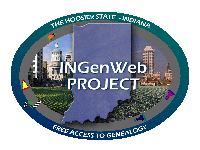
Miami County
INGenWeb Project


Photo is Seven Pillars natural rock formation in Miami County.
Cemetery HistoriesAllen Township In Allen township the first
burial place was laid out on the farm of Matthias Carvey, in Section 18, a short
distance northeast of the present town of Macy. Among the early burials here
were a Mr. and Mrs. Bailey, Matthias Carvey and a child of William Hakins. This
place is still called the Carvey cemetery. Not long after it was established a
graveyard was laid out at Five Corners, in the southwestern
part of the township, where Matthias Harmon, Nathan Bryant and a number of the
early settlers in that part of the county were buried. Many of the graves in
this old cemetery are unmarked and the names of those buried in them have been
forgotten. Butler
Township
Another old graveyard in
Butler township is located in the northwest corner of section 22, about a mile
and half of south of Peoria. A Christian church was built near this point about
1868, but it is not known whether the graveyard was established by the church or
not. There is a sort of tradition, not very well founded, that some burials had
been made there before the church was founded. Clay Township In the
atlas of Miami county published by Kingman Brothers in 1877, and also on a map
of Miami county published by Rand, McNally & Company in 1905, two cemeteries
are shown in Clay township. One of these is located near the United Brethren
church in section 28, about a mile and a half east of Bennett's Switch, (I
believe this is Chittick and is actually in Deer Creek Township.) and the other is a short distance southwest of the village of
Waupecong. Deer Creek Township Near the north
line of section 23, in the western part of Deer Creek township, is an old
cemetery that was once the churchyard of the Baptist church founded there in
1849. A number of the pioneers of the township were buried here during the
existence of the church, but since the congregation was disbanded in 1893 the
cemetery has fallen into decay through neglect and is rarely used. In the southern part of section 36, in the same township and not far
from the Howard county line, is another small burial place; there is also a
graveyard on the middle fork of Deer creek, in the northeast corner of section
29, about a mile east of Bennett's Switch, and another is situated in the east side of section
17, on the south bank of Deer creek and a short distance east of the village of
Miami. Erie Township The
county atlas and map above referred to show three cemeteries in Erie township.
The first is situated near the United Brethren church in section
8, in the northern part; the second is near the old Methodist
church in the southeast corner of section 10, and the third is
in the southwest quarter of section 21, just north of the Wabash railroad and in
what was once the Joseph Richardville reserve. Harrison Township In the
extreme northern part of Harrison township, just north of Pipe creek in the
northwest quarter of section 5, and a short distance southwest of the village of
Santa Fe, is an old country graveyard in which some of the early settlers of
that part of the county found their last resting place. The
McGrawsville Methodist church has a cemetery near that village; there is another just east of the village of North Grove; one in the northwestern part of section 8, north of the Pan Handle
railroad; and there is an old burial ground in the
southeastern part of the township that was once maintained by the Wesleyan
Methodist church of Cary, but it is no longer used, except on rare
occasions. Jackson Township The first cemetery in Jackson township was laid out on the farm of
Thomas Mason and the first burial there was that of an infant child of Thomas
and Mary Addington. This graveyard, afterward known as the Xenia cemetery, was
the beginning of the principal burial place at Converse, though in recent years
it has been greatly enlarged and improved. Second in
importance is the cemetery just north of Amboy, in the northern part of section
23, which is the principal place of interment for the people of the town and a
large district of the surrounding country. There is an old
cemetery in the south side of section 2, on the bank of Pipe creek and on
section 1, about a mile farther east is what was once known as the South Grove
Protestant cemetery. About half a mile northwest of
Converse is the churchyard of the Friends or Quakers, where the members of that
denomination and their friends bury their departed. Jefferson Township As narrated in Chapter VIII, the first person to die in Jefferson township was Solomon Wilkinson, who was buried just west of the Town of Mexico. That was the beginning of the Mexico cemetery. Other members of the Wilkinson family were among the early burials here. What is known as the Walling graveyard was established in the southwestern part of the township as early as 1836. Mrs. Burrell Daniels, whose husband built the first gristmill in the township, was buried here. This graveyard was abandoned as a burial place many years ago and the few graves there are now hardly distinguishable. The Eel River cemetery,
located in section 2, township 27, range 3, about two miles west of Mexico, was
established by the members of the Eel River chapel about 1838. On March 6, 1911,
a plat of the cemetery was filed in the office of the county recorder, by W. H.
Myers, though it has been used as a burial ground ever since it was first laid
out three quarters of a century ago. Perry Township In Perry township one of the oldest burial places is located in the east side of section 15, on the north bank of Squirrel creek and not far from the county line. It was kept up for a number of years by the Niconza Baptist church, but after the church went down the cemetery fell into disuse. Brant & Fuller's History of Miami County (page 719), in mentioning the death of James Bunton-the first death in Perry township-says: "He was buried in the Niconza graveyard, one of the oldest cemeteries in the county."There is an old cemetery in Perry township in the western part of section 4, "near the prairie," about a mile and a half west of the Wabash county line and near the northern boundary of the township. Another cemetery is situated in the western part of section 7, just north of Gilead and is the principal burial place for the people of that village and the neighboring rural districts. Peru Township Peru township, being the
site of the city of Peru, is naturally better supplied with burial grounds than
any other in the county, and its cemeteries are larger, better kept as a rule
and more pretentious than are those of the smaller towns and country districts.
Mount Hope cemetery was laid out about the year 1845 and comprised about three
acres of ground. In course of time this land was all sold for burial purposes
and at such low prices that there were no funds with which to keep the cemetery
in repair. In 1881 the Mount Hope Cemetery Association was only incorporated by
the commissioners of Miami county and in 1884 an assessment of $6 per lot was
levied for the purpose of providing funds for the improvement of the grounds. In
1908 another assessment of $2.50 per lot was levied, and some money was willed
to the association as an endowment. Pipe Creek Township Pipe Creek township is well supplied with burial places. In the east side of section 5, near the northern boundary of the township and east of the Lake Erie & Western Railroad, is an old graveyard that served as a place of interment for the early settlers in that neighborhood. This cemetery has been supplanted by one established by the United Brethren church about a mile farther west. There is an old burial ground in the north side of section 14, on what is known as the Medsker farm, not far from the Cass county line. About a mile south of this cemetery is one established by the Christian church soon after the close of the Civil war, and there is also a cemetery a short distance west of the town of Bunker Hill.Richland Township In Richland township, near
the center of section 1 and about two miles east of the old village of
Wooleytown, is what is left of an old graveyard established in an early day. The
oldest cemetery in the township, however, is the one at Chili, which was laid
out some time prior to 1840. There is also a graveyard in connection with the
German Baptist church in section 3, near the northwest corner of the township,
and another at the Baptist church at Chili. The last mentioned is situated on
the bank of the Eel river a short distance below the town. Referring again to the old
atlas and map previously mentioned, three cemeteries are noted in Union
township. One is situated in the northeast quarter of section 33, about a mile
northeast of Deedsville; the second is near the Missionary Baptist church in the
southern part of section 7, near Weesau creek and about three miles northwest of
the town of Denver; and the third is in section 16, just north of the old Weesau
Indian reservation. Washington Township In Washington township the
Wickler graveyard in the south side of section 15, about two miles south of the
county asylum, is one of the oldest cemeteries. It was established at a very
early day and one of the first persons to be buried there was a child of Robert
Love. The roads were in such condition at the time that it was difficult for
vehicles to pass over them and the little coffin was carried to the graveyard on
horseback by a Mr. Miller. Mr. Love, the father of the child, was also buried
here a little later. SOURCE: History of Miami County Indiana Chicago, Brant & Fuller 1887 |
| Resources, Addresses & Lookups | Biographies | Cemeteries | Census | Churches | Schools |
| Military | Photo Gallery | Vital Records | Geography, towns, maps | Surnames | Links |
 | This
site is maintained by Debby
Beheler This website is part of the USGenWeb Project. |
Debby Beheler ©1996-2012 All rights reserved